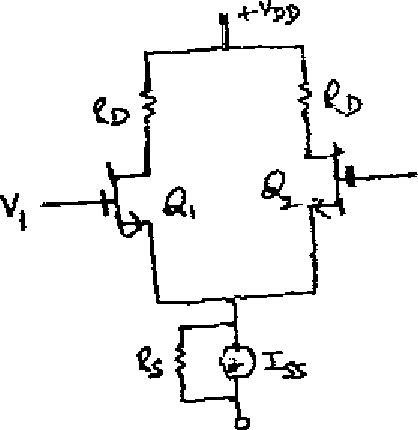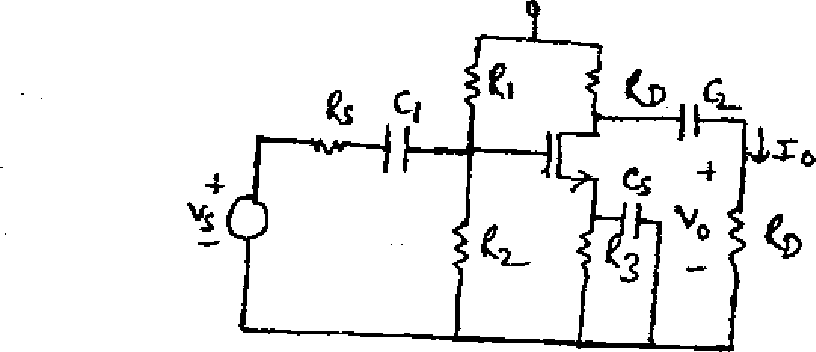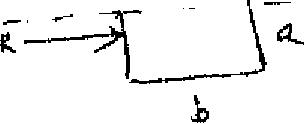University of Delhi 2009-4th Sem B.E Instrumentation and Control Engineering , NSIT, (Instrumentation and Technology) - Question Paper
See the pdf attachment for the ques. papers of all subjects of 4th semester.
Total No. ofPage(s): 3 Roll No,.................
FOURTH SEMESTER B.E. (ECE/COE/ICE/CE)
B.E. END SEM. EXAMINATION, May 2009 EC/COE/IC/CE-211 : ELECTRONICS - II
Time: 3:00 Hrs. Max. Marks: 70
Nate: Attempt ANY FIVE questions. All questions carry equal marks. Assume missing data if any, suitably._
[a] For the cascaded simplifier, shown in Fig.-l, each BJT has /? = 100 and rl.OAO, =0.5kQ.
Determine the overall voltage gain Au, Ri, Ri\ Ro, Ro'.
 | ||||||||
|
Rs so that \Adm\ = 100, and eMRR=90dB. [7] 
Fig.-2 [a] Calculate lower cutoff frequency (ft.) for the common source amplifier shown in Fig.-3. [8] 
Fig.-3 P>! Calculate the Bode plot log w versus gain (Au(jw)} and log w versus phase (Au(jw)) for the system gain * 100s(l + sf 20)  [a] The JFET in the circuit shown in Fig.-4 has gm = 2mxr, rd = 30Q , Cgs=10PF, Cgd=5PF and Cds=5PF. The BJT parameters are /? =125,C*=100PF arid CM=1.5PF i) Determine Auo and the approximate value /h, ii) Estimate the frequency of the nearest nondominant pole. [10] 
- Fig .-4 [b] Define rise time (tr) and tilt used for square wave testing of an amplifier. What is the relation between tilt and ft,. [4] [a] For the circuit shown in Fig.-5, identify the feedback topology. Given that transistors Qi, Q2 and Q3 are biased at IcQi=0.25mA, IeQ2=l-0mA, and IcQ3=0.5mA. Bi=B2::;B3=200j and Va= for all the transistors. The circuit elements swww.JSiionifoeQ, Rc2=7.5kf2, Rc3=10ki2, Ri=0.2kfi, f?2=0.33kQ and Rs=0.6kfl, and Rp=20kQ. Calculate {aI, and R0j . [10]
Fig.-5 [b] Enumerate the effects of negative feedback on gain, frequency response, input and output impedances.[4] 5. [a] Explain the working of a Class-B complementary symmetry push-pull amplifier. For this amplifier deduce i) Conversion efficiency fa) ii) Maximum collector dissipation (Pe max) iii) Power delivered to the load (PL max) iv) Relation between Pc max and Pl max- [b] Determine the maximum conversion Class-A power amplifier. [a] With the help of neat circuit diagram, explain the working of a Wiens Bridge oscillator. Derive its frequency of oscillation and the gain needed by the amplifier. [7] [b] Determine the value of capacitor required so that the Hartley oscillator, oscillators at the frequency of 450KHz. Given Li=lpH, L2=100|iH- [7] Total No. ofPage(s): 2 Roll No........................ FOURTH SEMESTER B.E. (ICE) B.E. END SEM. EXAMINATION, May 2009 IC-212 : FLUID MECHANICS & THERMO. Time: 3:00 Hrs. Max. Marks: 70 Note: Attempt ANY FIVE questions. PART-A (FLUID MECHANICS! [a] A velocity profile of a flowing fluid over a flat plate is parabolic and given by u = ay + by + c, where a, b. and c constants. The velocity of the fluid is 1.5m/sec at 20cm from the plate, which is the vertex point of the velocity distribution. Find out the velocity gradient and shear stress at y = 0, 10 and 20cm respectively. [8] Or 1-2*} 777777 , 4<x [b] Define surface tension and prove that the Ap ~ where Ap is the pressure difference between inside and outside of the liquid droplet. D is the diameter of the liquid and <j is the surface tension between liquid and air. [6J Prove that the pressure intensity on the liquid is directly proportional to the height of a point from the free surface of liquid. [5] [b] A box is made of a triangular section of lm side and 3m long close from both ends and completely filled with water. Find the total force acting on (i) Triangular ends (ii) inclined surfaces and their respective point of action. [9] [a] Explain the stability of completely submerged bodies. [5] [b] A hollow wooden cylinder with inside and outside diameters of 60cm and 30cm floats in an oil of specific gravity of 0.9. Find the maximum height of cylinder if it has to float in stable equilibrium condition with its axis vertical. Sp. Gravity of wooden cyWwW0P'!ntifl]ejfji [9] [a] Develop Eulers equation of motion and then derive Bernoullis equation and list out some practical applications. What are the limitations of Bernoullis equation? [6] [b] A drainage pipe is tapered is section running full of water. The pipe diameter at inlet and exit are 100cm and 50cm respectively. The water surface is 2m above the centre of the inlet and exit is 3m above the free surface of the water. The pressure at the exit is 25cm of Hg vaccume. The friction loss between inlet and exit of the pipe is 1 /10 of the velocity head at the exit. Determine the" discharge passing through the pipe. . [8] PART-B (THERMODYNAMICS) What is a Thermodynamic system? Give the difference between closed system and open system. [7] P>I Show that heat transfer is a path function, and not a property. [7] 2. [a] Explain what is a polytropic process, with P-V diagram, how does it differ from adiabatic process. [6] P>] Three gram of nitrogen gas at 6atm and 160C in a frictionless piston cylinder device is expanded adiabatically to double its initial volume, then compressed at constant pressure to its initial volume and then again compressed at constant volume to its initial state. Calculate the net work done on the Gas. Draw P-V diagram for the processes. [8] 3. [a] Explain what is a steady flow-engineering device. [5] An insulated rigid tank initially at zero pressure is connected through a valve to an infinite source supply line of steam at 600 KPa and 250C. The valve is slowly opened to allow the steam to flow into the tank until pressure reaches 600KPa, and this point valve is closed. Calculate the final temperature of steam in the tank. [9] 4. Write the short notes on any four of the following: Increase of entropy principle for closed system [b] Enthalpy-Entropy diagram T-V diagram for a pure system [d] P-V diagram for a pure system [e] Cause of Entropy change. [14] End Semester Examination, May 2009 BE (ICE): 4th Semester 1C - 213 : Electronic Instrumentation & Note: Attempt Any 5 Questions. 1. (a) Explain any two applications of Op-Amp with circuit Discuss the characteristics of ideal Op-Amp. 1. (b) Design and Explain an Op-Amp amplifier with the following gain: Vout = Va + Vb - Vc 2. (a) Describe (a) Successive approximation type and (b) Ramp Type Digital Volt Meter (DVM) with block diagram. 2. (b) How can you calculate the resolution of 4 digit DVM. 3. (a) Describe the operation of CRT with diagram. Explain functioning of Graticules and Phosphors. 3. (b) In CRT, calculate electrostatic deflection, deflection sensitivity and deflection factor. 4. (a) Explain the Harmonic Distortion analysers OR Frequency Selective Wave Analysers with diagram. 4. (b) Discuss the basic block diagram of Spectrum Analyser. 5. (a) Explain the block diagram of any two types of Data Acquisition systems (DAS). 5. (b) Design a Time Division Multiplexing (TDM) System to transmit digital data. 6 (a) Explain and Design a XOR gate using AND, OR and NOT gate. 6. (b) Explain the waveforms, equations and block diagrams of Amplitude and Frequency Modulation. 7. (a) Describe the working of Storage Digital CRO with block diagram. 7. (b) Design and Describe any 2 types of active filters using Op-Amp. 8. (a) Explain Digital LCR - Q meter with diagram. 8. (b) Describe the working of Digital Multimeter with diagram. Total No. ofPage(s): 3 Roll No.................. FOURTH SEMESTER B.E. (ICE) B.E. END SEM. EXAMINATION, May 2009 IC-214 : COMPUTER GRAPHICS Time: 3:00 Hrs. Max. Marks: 70 Note: Attempt ANY FIVE questions. All questions carry equal marks. [a] Modify Bresenhams Line drawing algorithm so that it will produce i) Dashed line - The dash length should be independent of slope ii) A line of thickness w pixels. [6] Use the midpoint method and symmetry considerations to scan convert a parabola y = lOOx . [5] [c] Derive the transformation matrix for scaling an object by a scaling factors in a description specified by the direction angles a, p and y. [3] [a] The coordinates of the vertices of a polygon are shown in Fig.-1. Sj __ V* c Si*) 
v.o/0- Fig.-l Using solid area scan conversion algorithm show how the interior of the polygon is filled. [5] [b] Briefly explain the viewing pipeline while displaying 3D objects on a 2D screen. [5] cj Prove that the multiplication of three-dimensional transformation matrices for each of the following sequence of operations is commutative: i) Any two successive translations ii) Any two successive rotations about any one of the coordinate axes.www.nsitonline.in [4] [a] What is the sequence of transformations required to change the position of object shown in Fig.-2 to Fig.-3. [4] % Fig--3
Fig.-2 P] A cube with sides of length 2 is placed so that a corners lies on the origin and three mutually perpendicular edges from this corner lie on three positive coordinate axes. Perform a 3-point perspective projection on the translated cube on the z=0 plane with centres of projection jc = -10, y -10 and z= 10 on the respective coordinate axes. Give the coordinates of the projected cube. [7] [c] Describe briefly the applications of computer graphics. [31 [a] Show that two curves P(t)={t2-2i, f) and Q{t) = (f2 +1, f + l] are both C' and G' continuous where they join at p{\.) = Q(o). [5] n*i An 8 is constructed by joining together two cubic bezier curves, one for the top half, the other for the bottom half. Show how the 4 points have to be arranged for each curve (two end pints and two control points) so that the curves joins smoothly. [5] [c] Determine 3D transformation matrices to scale the line. AB in z direction by 3.5 by keeping point A fixed. Then rotate this line by 45 anticlockwise about x-axis. Given A( 10, 15, 20) and B(45, 60, 30). [4] [a] Define bezier curves. Discuss their properties and limitations. [4] [b] Suppose an image of a 3D world, viewed from a particular position is projected on to a display area on a monitor. Derive the equations for a perspective projection, which given the view coordinate of a point in 3D space, produce the user coordinates of the point P that projects onto. [6] [cl Find a transformation matrix which aligns the vector V = I + J + K with the vector N = 21 J -K . [4] [a] Given points A(4,5, 6.8), B(-1.2, 1.0) and C(8.4, -2.5). Find their respective screen coordinates. Use the following assumptions: the screen is 512x512 pixels and the window is the minimum square that encloses the points and fill the upper lift quadrant of the screen. The reason that homogeneous coordinates are attractive is that 3D points at infinity in Cartesian coordinates can be represented explicitly in homogeneous coordinates. How can this be done? [2] [c] Describe with the aid of a diagram, the stages involved in rotating an object about an arbitrary axis. [6] 7. Write short notes on any four of the following: [a] Random Scan and Raster Scan [b] NLN Line clipping algorithm [c] Direct View Storage Tube (DVST) Id] Weiter-Atherton polygon clipping [e] Window to viewport transformation [f] Herbnite curves. [14] Roll No:..............................Page 1 of 2 Date................ B.E.(ICE)-IV SEMESTER END-TERM EXAMINATION, May200* COURSE CODE: IC-215 TITLE: TRANSDUCERS AND COMPONENTS TIME ALLOWED: 3.00Hrs_M.M: 70 _____ _Note : Attempt any five questions. Assume missing data suitably, if any._ 1. a. A PZT has a capacitance of lOOOpF and a charge sensitivity of 40xl0'3C/m. The connecting cable has a capacitance of 3GGpF while the oscilloscope used for readout has a readout input resistance of 1MQ with a parallel capacitance of 50pF. What is the lowest frequency that can be measured with 5% amplitude error by the entire system? What is the value of the external shunt capacitance that can be connected in order to extend the range of 5% error down to 10Hz? [8] b, Find the mathematical expression for frequency response of PZT. Use the frequency response expression to find the suitability of PZT to measure a force of ION. [6] 2. a. A thermocouple having first order response characteristics is used to measure a single thermal pulse having half wav e sinusoidal shape of 10C peak amplitude. Find Hie output response of the thermocouple for 4t and 10 t, t being the time constant of the thermocouple. [10] b. Explain the working principle of photo transistor. Draw the typical characteristic plot of photo transistor. [4] 3. a. Explain the working of strain gauge and derive the expression for gauge factor. Describe techniques for strain gauge calibration and thermal compensation. [6] b. A load cell is formed of a hollow steel cylinder loaded axially as shown in adjoining Figure. The four strain gauges are so connected to enhance the signal and provide the thermal compensation. The load cell has a cross sectional area of 2cm Youngs modulus of steel is 2.07xl0nN/m2 and Poissons ratio of 0.3. Given the strain gauge resistance of 1000Q, and Gauge factor is 2.1. The current in each gauge has the upper limit of 20mA. Calculate, i. Supply voltage, ii, current in the detector arm if it consists of a micro ammeter of 500 Q, when the load cell is subjected to a force of 105N. [8] 
4. a. A resistive potentiometer is rated as 200 ohms, 1W. (de-rates at 10mW/C above 60C), 30C/W thermal resistance. It is used with 10V supply at 70C ambient temperature. Calculate, [8] i) Power dissipated by potentiometer ii) Actual temperature of the potentiometer iii) Power dissipation allowed iv) Is it safe to use the device under the above mentioned conditions? b. Explain a suitable configuration of capacitive transducer for angular measurement. [6] 5. a. Discuss in detail the working principle and applications of LVDT. Give various configurations of LVDT. Draw the typical characteristic plot of LVDT. [6] b. Discuss open lop and closed loop systems. Why close loop systems are preferred over open loop systems? Define all the control mechanisms. Why derivative control is not used alone? [8] 6. a. Explain Hall Effect and suggest its applicability for measurement of physical quantities. [5] b. Explain the working principle of photo voltaic cell. Why these are very useful for space applications? [3] c. What is the Hot Wire Anemometer? Explain its working with the help of a neat diagram. [6] 7. a. Define and explain briefly the static performance parameters of an instrumentation system. [6] b. Define a measurement system. What are all the parameters need to be considered in selecting an instrumentation system? You may explain with the help of an example. [6] c. What are sensors and transducers? What is the role of each in a measurement system? [2] 8. Write short notes with the application on any three. [14] a. Encoder b. Electromagnetic Flow Meter c. Techogenerator d. Bellows and Bourdon tubes e. Accelerometer and vibration pick-ups f. Signal conditioning Id] Millars theorem aiwWWtBPiJOnlaie-in [14]
|


